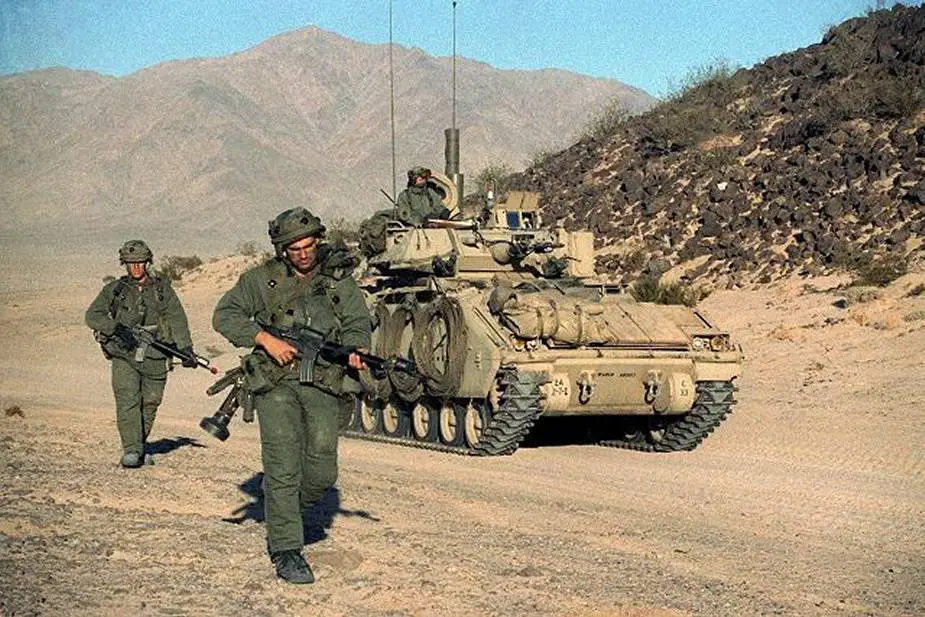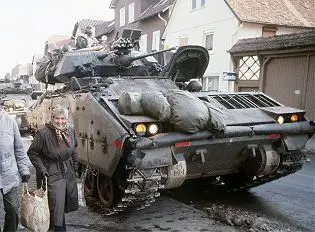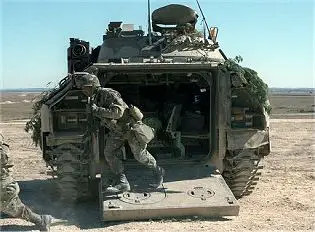- Army
- Air Defense Systems
- Anti-tank systems and vehicles
- Armored Vehicles
- Armoured personnel carriers
- Artillery Vehicles and Weapons
- Command Post
- Communication Vehicles and Systems
- Electronic Warfare
- Engineer | Maintenance Vehicles
- Infantry Fighting Vehicles
- Main Battle Tanks
- Missiles
- Tactical and Logistic Vehicles
- Radars
- Unmanned Systems
- Weapons
- Navy
- Air
Bradley M2
Bradley M2 AIFV
Tracked Armored Infantry Fighting Vehicle - United States

Description
The Bradley M2 was the standard Armoured Infantry Fighting Vehicle (AIFV) of the U.S. Army since 1983. The first version of the vehicle has undergone many improvements, upgrading and modernization programs to achieve the version of M2A1, M2A3, and M2 A2. In April 1972, the US Army issued a Request For Proposals (RFP) for a new armored infantry fighting vehicle. The first prototype was called XM723 which was fully completed by the Summer of 1975. After the latest improvements on the XM723, the vehicle was called Fighting Vehicle System (FVS) which consisted of two vehicles, the XM2 Infantry Fighting Vehicle and the XM3 Cavalry Fighting Vehicle. The IFV and CFV are almost identical in appearance except the CFV carry five men (the crew of three and two scouts), has the firing ports blanked off, and has greater ammunition capacity. The first two prototypes of the XM2 Infantry Fighting Vehicle were handed over to the US Army at San Jose, California in December 1978 and the remaining six were completed by March 1979. In December 1979, the XM2 was type-classified as the M2 and the XM3 as the M3. The first unit equipped with the M2 was a battalion at Fort Hood, Texas, in March 1983, with the US Army Training Centre in Vilseck, Germany, receiving deliveries in September 1983. The new variants of the Bradley M2 are manufactured by BAE Systems Land & Armaments (formerly United Defence) and include the M2 infantry fighting vehicle and the M3 cavalry fighting vehicle. Currently, 6,720 vehicles of both types are in service with the U.S. armed forces. In October 2012, BAE Systems received a $55 million contract for the second phase of the Engineering Change Proposal (ECP) effort for the Bradley Fighting Vehicle – one of the most survivable and reliable combat systems in the U.S. Army inventory. This contract continues the ECP research and development efforts to upgrade the full Bradley fleet and improve the overall vehicle performance for the U.S. Army. Last year, the company received $16 million in funding under this contract. The full value contract is expected to reach $234 million. U.S. Army plans to replace the M2 Bradley with the GCV (Ground Combat Vehicle) Infantry Fighting Vehicle by 2018.
Bradley M2 AIFV variants:
- Bradley M2: The basic production model, first fielded in 1981
- Bradley M2A1: Introduced in 1986, the A1 variant included an improved TOW II missile system, a Gas Particulate Filter Units (GPFU) NBC system, and a fire-suppression system. By 1992, the M2A1s had begun being remanufactured to upgraded standards.
- Bradley M2A2: Introduced in 1988, new engine, new armor with protection against 30 mm APDS rounds and RPGs (or similar anti-armor weapons).
- Bradley M2A3: Introduced in 2000, the A3 upgrades make the Bradley IFV totally digital and upgrade or improve existing electronics systems throughout improving target acquisition and fire control, navigation, and situational awareness. Also, the survivability of the vehicle is upgraded with a series of armor improvements, again both passive and reactive, as well as improved fire-suppression systems and NBC equipment.
- Bradley BCP: The Bradley BCP is a Command Post tracked armored vehicle based on the chassis of the armored infantry fighting vehicle Bradley.
- Bradley M6 Linebacker: The Bradley-Linebacker Short-Range Air Defense (SHORAD) system is essentially a United Defense Bradley infantry fighting vehicle with the twin Raytheon Systems Company TOW anti-tank guided missile system replaced by a pod containing four Stinger fire-and-forget Surface-to-Air Missiles (SAM).
- Bradley M7 FIST: Bradley FIST (Fire Support Team) vehicle for the US Army field artillery.
- Bradley AMEV: The Bradley AMEV delivers life-saving combat medical support and protection for casualties, evacuees and combat medics, while providing mobility and survivability equal to the supported Abrams and Bradley-equipped maneuver force.
- Bradley AMTV: The Bradley AMTV provides combat medical support to the Heavy Brigade Combat Team. The AMTV provides the capability to emplace forward surgical teams closer to the point of injury, allowing advanced trauma management and intervention treatment on today’s battlefield.
- Bradley Mortar Vehicle: The Bradley Mortar Vehicle’s large interior volume enables the vehicle to carry up to 115 rounds of 120mm mortars, which facilitates the crew’s ability to provide a longer duration of sustainable fires
Technical Data
| Armament |
|
The turret of the Bradley M2 is mounted in the center of the vehicle offset to the right with the gunner seated on the left and the commander on the right. Each crew member is provided with a single-piece hatch cover that opens to the rear. The turret has a 360º electric traverse and the weapons can be elevated from -10 to +60º and is fully stabilized. The main armament consists of the ATK Gun Systems Company M242 25 mm Bushmaster Chain Gun with a 7.62 mm M240C machine gun mounted coaxially to the right of the main armament. The gun contains ammunition in two ready boxes of 70 rounds and 230 rounds each for a total of 300 ready rounds and carries 600 rounds in storage. The two ready boxes allow a selectable mix of rounds such as the M791 APDS-T (Armor-Piercing Discarding Sabot (with) Tracer), and M792 HEI-T (High Explosive Incendiary (with) Tracer) rounds. A 7.62mm M240 machine gun is mounted coaxially to the right of the main armament with 2,200 rounds of 7.62 mm ammunition. Two BGM-71 TOW wire-guided missile launchers are mounted to the left side of the turret which are able to destroy most of the modern main battle tanks out to a maximum range of 3,750 m. In the travel position, the TOW launcher is lowered and lies along the left side of the turret. The TOW missile launcher has an elevation of +30º and a depression of -20º. A total of eight smoke grenade launchers are mounted on the forward part of the turret, four to each side of the main armament.
|
| Design and protection |
|
The hull and the turret of the Bradley M2 are made of all-welded aluminum armor with spaced laminate armor fitted to the hull, sides, and rear. The crew and the soldiers are protected from inside the vehicle against RPG (rocket-propelled grenade), ballistic threats 30 mm APDS (Armour-Piercing Discarding Sabot) ammunitions, and artillery shell splinters 155mm. The driver sits at the front of the vehicle on the left and has a single-piece hatch cover that opens to the rear. The M2 carries seven infantry. One sits forward of the turret on the left side facing the rear, one to the left of the turret facing the front, one at the left rear of the vehicle facing inwards, two sit at the right rear-facing the back, and two seats at the back of the turret facing the front. The infantrymen enter and leave the vehicle through a large hydraulically operated ramp at the rear of the hull, which has an integral door on the left side. A single-piece hatch cover opening to the rear is over the top of the troop compartment. Six firing ports, two on each side of the hull and two at the rear, each with a day periscope over it, enable the crew to fire with assault rifles or individual weapons from inside the vehicle.
|
| Mobility |
| The M2 Bradley is motorized with a Cummins VTA-903T turbocharged 8-cylinder diesel developing 600 hp at 2,600 rpm coupled to a General Dynamics Land Systems HMPT-500-3EC TEC hydromechanical transmission. The engine compartment is to the right of the driver. The torsion bars suspension of the Bradley M2 includes each side six dual rubber-tired road wheels with the drive sprocket at the front and the idler at the rear. There are two track-return rollers that support the inside of the track only and one double roller. Hydraulic shock absorbers are fitted to the first, second, third, and sixth roadwheel stations. |
| Combat Equipment |
| The Bradley M2 is equipped with one fixed fire extinguisher in the engine compartment, two automatic fire extinguishers in the personnel compartment, and two 1.2 kg portable fire extinguishers. The vehicle is also equipped with day periscopes and AN/VVS-2 passive night periscopes for the driver. The gunner has a combined day/thermal sight with an optical relay for the commander with magnifications of ×4 and ×12, as well as periscopes for front and side observation. Standard equipment of the Bradley M2 includes a central NBC M13A1 gas particulate filter system for the commander, gunner, and driver but the dismounted infantry must wear individual masks when in an NBC environment. The M2 was fully amphibious and propelled in the water by its tracks. Before entering the water a special water barrier must be erected. This takes approximately 30 minutes with a trained crew. |
Specifications
| Armament | Armor |
| One 25mm M242 cannon, one 7.62mm M240C coaxial machine gun, 2 TOW launchers and 2x4 smoke grenade launchers | Spaced laminate armor. RPG and 30 mm APDS all-around protection (with armor upgrades) and shell splinters 155mm |
| Country users | Weight |
| United States | 27,797 kg |
| Designer Country | Speed |
| United States | 66 km/h |
| Accessories | Range |
| NBC protection system, night vision, automatic fire extinguishers |
480 km |
| Crew | Dimensions |
| 3 + 6 soldiers | Length: 6.45 m; Width: 3.20 m; Height: 2.97 m |
Details View
 |
|
 |
 |
 |
 |
Pictures - Video



























